The global foil laminates market is valued at USD 34.6 billion in 2025 and is slated to reach USD 78.4 billion by 2035, recording an absolute increase of USD 43.8 billion over the forecast period. This translates into a total growth of 126.6%, with the market forecast to expand at a CAGR of 8.5% between 2025 and 2035. The market size is expected to grow by nearly 2.27X during the same period, supported by increasing demand for barrier packaging solutions, growing adoption of flexible packaging in consumer goods, and rising preference for moisture-resistant and oxygen-barrier materials across diverse industrial applications.
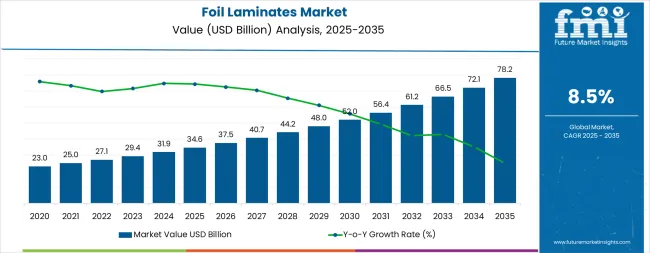
Between 2025 and 2030, the foil laminates market is projected to expand from USD 34.6 billion to USD 51.8 billion, resulting in a value increase of USD 17.2 billion, which represents 39.3% of the total forecast growth for the decade. This phase of development will be shaped by increasing food packaging industry expansion, rising adoption of advanced coating technologies, and growing demand for extended shelf-life packaging in ready-to-eat meals and pharmaceutical products. Packaging manufacturers are expanding their foil laminate production capabilities to address the growing demand for high-barrier solutions and lightweight packaging materials.
| Metric | Value |
|---|---|
| Estimated Value in (2025E) | USD 34.6 billion |
| Forecast Value in (2035F) | USD 78.4 billion |
| Forecast CAGR (2025 to 2035) | 8.5% |
The foil laminates market is driven by several key parent markets, with the packaging industry being the largest contributor, accounting for around 40-45%. Foil laminates are essential in providing superior barrier properties, protecting products like food, beverages, and pharmaceuticals from moisture, light, and oxygen. This ensures extended shelf life and maintains the integrity of the products. The food and beverage market follows closely, contributing approximately 20-25%, as foil laminates are commonly used in the packaging of snacks, dairy products, and ready-to-eat meals. These materials help preserve freshness and flavor, making them highly sought after for perishable food items. The pharmaceutical packaging market, contributing 15-20%, relies on foil laminates for their protective qualities in safeguarding medicines from external elements.
The cosmetics and personal care market also plays a significant role, with a 10-12% share, as foil laminates are increasingly used to package skincare, cosmetic, and personal care products. The combination of protection and aesthetic appeal makes foil laminates a preferred choice in this sector. The electrical and electronics market contributes around 5-8%, where foil laminates are utilized to protect electronic components and batteries from moisture and static. These diverse parent markets emphasize the broad applications of foil laminates, driven by the need for packaging materials that offer protection, extend product shelf life, and provide a visually appealing package for various industries.
Market expansion is being supported by the increasing global demand for flexible packaging solutions and the corresponding need for high-barrier materials that can maintain product freshness and quality while extending shelf life across various consumer goods applications. Modern packaging manufacturers are increasingly focused on implementing material solutions that can provide superior moisture resistance, oxygen barrier properties, and visual appeal in consumer-facing packaging. Foil laminates' proven ability to deliver exceptional barrier performance, lightweight construction, and versatile printing capabilities make them essential materials for contemporary packaging and product protection solutions.
The growing emphasis on food safety and product integrity is driving demand for foil laminates that can support pharmaceutical packaging, premium food products, and sensitive electronic components requiring protection from environmental factors. Packaging converters' preference for materials that combine barrier performance with operational efficiency and cost-effectiveness is creating opportunities for innovative foil laminate implementations. The rising influence of convenience-oriented consumer trends and portion control packaging is also contributing to increased adoption of foil laminates that can provide single-serve packaging solutions and resealable formats.
The foil laminates market is poised for rapid growth and transformation. As brand owners and converters across both developed and emerging markets seek packaging materials that are high-barrier, lightweight, printable, and cost-efficient, foil laminates are gaining prominence not just as premium packaging solutions but as strategic materials in food packaging, pharmaceuticals, personal care, and industrial applications.
Rising incomes and urbanization in Asia-Pacific, Latin America, and Africa amplify demand, while manufacturers are picking up on innovations in metallization technologies and lamination improvements.
Pathways like recyclable structures, premium barrier solutions, and application-specific differentiation promise strong margin uplift, especially in mature markets. Geographic expansion and localization will capture volume, particularly where cold chain infrastructure is developing or premium product penetration is increasing. Regulatory pressures around food safety, packaging waste reduction, and product protection give structural support.
The market is segmented by material type, structure, end use, and region. By material type, the market is divided into aluminum-based laminates, metallized film laminates, and paper-foil laminates. By structure, it covers 2-layer, 3-layer, and multi-layer (4+ layers). By barrier type, it is segmented into high barrier, medium barrier, and low barrier. The lamination methods include adhesive lamination, extrusion lamination, and thermal lamination. Based on end use, the market is categorized into food & beverage packaging, pharmaceutical packaging, personal care & cosmetics, and industrial applications. Regionally, the market is divided into North America, Europe, East Asia, South Asia & Pacific, Latin America, and the Middle East & Africa.
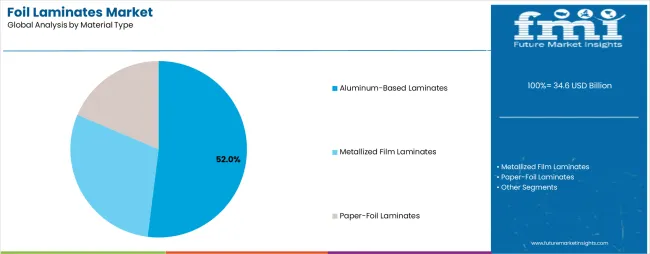
The aluminum-based laminates segment is projected to account for 52% of the foil laminates market in 2025, reaffirming its position as the leading material category. Packaging converters increasingly utilize aluminum-based laminates for their superior barrier properties, excellent moisture resistance, and proven performance in protecting sensitive products across food, pharmaceutical, and industrial applications. Aluminum foil technology's advanced processing capabilities and consistent quality output directly address the industrial requirements for reliable product protection and operational efficiency in high-speed packaging operations.
This material segment forms the foundation of modern flexible packaging operations, as it represents the material with the greatest barrier effectiveness and established market demand across multiple packaging categories and product types. Converter investments in enhanced lamination technologies and quality control systems continue to strengthen adoption among brand owners. With packaging companies prioritizing product shelf life and moisture protection, aluminum-based laminates align with both performance objectives and consumer safety requirements, making them the central component of comprehensive packaging protection strategies.
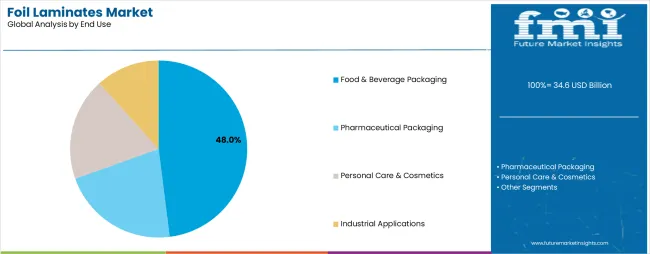
Food & beverage packaging is projected to represent 48% of foil laminate demand in 2025, underscoring its critical role as the primary industrial consumer of high-barrier flexible packaging materials for consumer product protection. Food packaging companies prefer foil laminates for their exceptional barrier properties, visual appeal capabilities, and ability to enhance product presentation while extending shelf life and maintaining freshness. Positioned as essential materials for modern food packaging, foil laminates offer both functional advantages and marketing benefits.
The segment is supported by continuous innovation in packaging design and the growing availability of specialized lamination technologies that enable premium package development with enhanced consumer convenience features. Food manufacturers are investing in supply chain optimization to support large-volume packaging procurement and quality assurance. As convenience food demand becomes more prevalent and premium packaging requirements increase, food & beverage packaging will continue to dominate the end-use market while supporting advanced material utilization and package innovation strategies.
The foil laminates market is advancing rapidly due to increasing consumer demand for packaged convenience foods and growing adoption of high-barrier packaging materials that provide extended shelf life and product protection across diverse consumer goods applications. The market faces challenges, including raw material price volatility, recycling infrastructure limitations, and the need for advanced lamination equipment investments. Innovation in metallization technologies and multi-layer barrier structures continues to influence product development and market expansion patterns.
The growing adoption of vacuum metallization and plasma-enhanced coating technologies is enabling packaging converters to produce premium foil laminates with superior barrier properties, enhanced visual aesthetics, and improved environmental profiles. Advanced metallization systems provide better material efficiency while allowing more consistent barrier performance across various substrate types and applications. Manufacturers are increasingly recognizing the competitive advantages of advanced metallization capabilities for product differentiation and premium market positioning.
Modern foil laminate producers are incorporating intelligent packaging features and digital printing technologies to enhance consumer engagement, enable brand protection, and ensure product authenticity throughout distribution channels. These technologies improve supply chain transparency while enabling new applications, including anti-counterfeiting measures and freshness monitoring capabilities. Advanced feature integration also allows converters to support premium product positioning and consumer interaction beyond traditional barrier packaging functions.
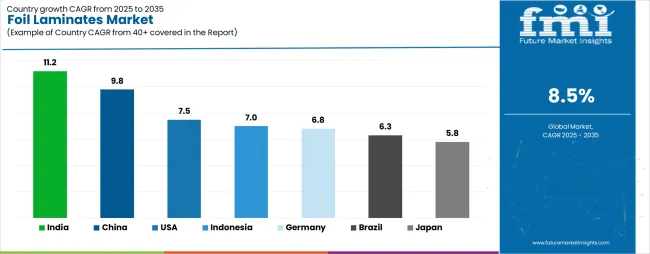
| Country | CAGR (2025-2035) |
|---|---|
| India | 11.2% |
| China | 9.8% |
| USA | 7.5% |
| Indonesia | 7.0% |
| Germany | 6.8% |
| Brazil | 6.3% |
| Japan | 5.8% |
The foil laminates market is experiencing strong growth globally, with India leading at an 11.2% CAGR through 2035, driven by the expanding packaged food industry, growing pharmaceutical sector, and significant investment in flexible packaging infrastructure development. China follows at 9.8%, supported by large-scale manufacturing capabilities, advanced lamination facilities, and growing domestic demand for consumer packaged goods. The USA shows growth at 7.5%, emphasizing technological innovation and premium packaging development. Indonesia records 7.0%, focusing on food packaging expansion and growing middle-class consumption. Germany demonstrates 6.8% growth, prioritizing advanced barrier technologies and pharmaceutical packaging applications. Brazil exhibits 6.3% growth, emphasizing processed food packaging expansion and retail market development. Japan shows 5.8% growth, supported by premium packaging solutions and technological innovation.
The report covers an in-depth analysis of 40+ countries; seven top-performing countries are highlighted below.
Revenue from foil laminates in India is projected to exhibit exceptional growth with a CAGR of 11.2% through 2035, driven by expanding flexible packaging infrastructure and rapidly growing consumer goods sectors supported by government manufacturing promotion initiatives. The country's large population and increasing purchasing power are creating substantial demand for packaged food and pharmaceutical products. Major packaging converters and multinational companies are establishing comprehensive lamination capabilities to serve both domestic and export markets.
Revenue from foil laminates in China is expanding at a CAGR of 9.8%, supported by the country's large-scale manufacturing capacity, advanced processing facilities, and increasing domestic demand for packaged consumer goods and pharmaceutical products. The country's comprehensive packaging supply chain and growing e-commerce industry are driving demand for sophisticated lamination capabilities. International technology providers and domestic converters are establishing extensive production and distribution capabilities to address the growing demand for high-barrier packaging materials.
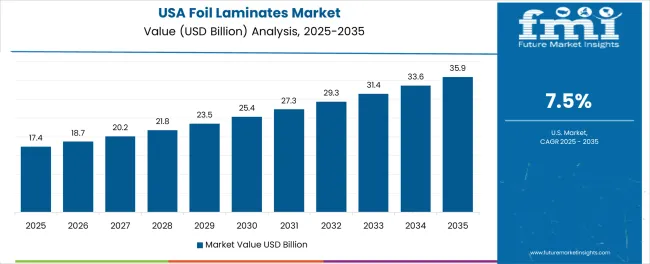
Revenue from foil laminates in the USA is expanding at a CAGR of 7.5%, supported by the country's advanced packaging industry, strong emphasis on technological innovation, and robust demand for convenience foods among time-conscious consumers. The nation's mature packaging sector and high consumption of ready-to-eat products are driving sophisticated lamination capabilities throughout the supply chain. Leading converters and material suppliers are investing extensively in premium product development and advanced barrier technologies to serve both domestic and export markets.
Revenue from foil laminates in Indonesia is growing at a CAGR of 7.0%, driven by expanding packaged food consumption, increasing middle-class population, and growing investment in modern retail infrastructure. The country's large population and rapidly developing consumer goods sector are supporting demand for flexible packaging materials across major urban centers. Local converters and international packaging companies are establishing comprehensive capabilities to serve both domestic food manufacturers and regional export markets.
Revenue from foil laminates in Germany is expanding at a CAGR of 6.8%, supported by the country's advanced packaging engineering expertise, strong pharmaceutical industry presence, and strategic position for European market supply. Germany's established pharmaceutical manufacturing base and premium food packaging sector are driving demand for specialized lamination technologies focusing on high-barrier applications and regulatory compliance. Converters are investing in comprehensive testing facilities to serve both domestic and international markets with certified packaging materials.
Revenue from foil laminates in Brazil is growing at a CAGR of 6.3%, driven by the country's expanding processed food industry, increasing urban consumption patterns, and growing investment in modern packaging infrastructure. Brazil's large domestic market and agricultural processing capabilities are supporting demand for flexible packaging materials throughout major production regions. Food processors and packaging converters are establishing comprehensive capabilities to serve both domestic retail chains and regional export opportunities.
Revenue from foil laminates in Japan is expanding at a CAGR of 5.8%, supported by the country's focus on premium packaging aesthetics, advanced material science research, and strong consumer preference for high-quality product presentation. Japan's sophisticated packaging industry and emphasis on visual design excellence are driving demand for advanced metallization technologies including holographic effects and color-shifting appearances. Leading converters are investing in specialized capabilities to serve premium food brands, cosmetics manufacturers, and pharmaceutical companies with innovative packaging solutions.
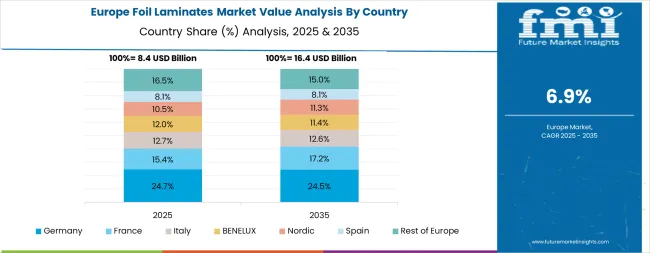
The foil laminates market in Europe is projected to grow from USD 8.2 billion in 2025 to USD 17.8 billion by 2035, registering a CAGR of 8.1% over the forecast period. Germany is expected to maintain its leadership position with a 29.0% market share in 2025, stable at 29.0% by 2035, supported by its strong pharmaceutical packaging industry, advanced lamination facilities, and comprehensive flexible packaging supply network serving major European markets.
France follows with a 17.0% share in 2025, projected to reach 17.5% by 2035, driven by robust demand for foil laminates in premium food packaging, cosmetics applications, and dairy product protection, combined with established luxury brand requirements for sophisticated packaging materials. The United Kingdom holds a 15.0% share in 2025, expected to stabilize at 15.0% by 2035, supported by strong pharmaceutical sector demand and convenience food packaging requirements. Italy commands a 13.0% share in 2025, projected to reach 13.5% by 2035, while Spain accounts for 11.0% in 2025, expected to reach 11.5% by 2035. The Netherlands maintains a 4.0% share in 2025, growing to 4.2% by 2035. The Rest of Europe region, including Nordic countries, Eastern Europe, Switzerland, Belgium, Austria, and Poland, is anticipated to gain momentum, expanding its collective share from 10.0% to 9.3% by 2035, attributed to increasing adoption of flexible packaging in Nordic food markets and growing pharmaceutical manufacturing activities across Eastern European countries implementing modernization programs.
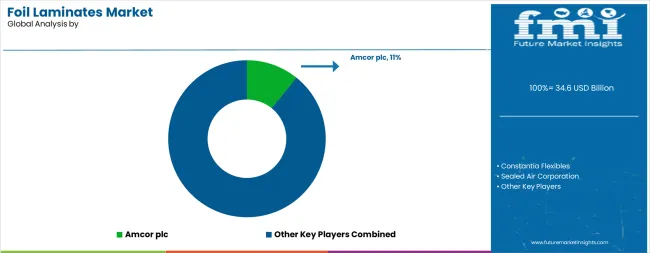
The foil laminates market is characterized by competition among established flexible packaging companies, specialized lamination technology providers, and integrated material suppliers. Companies are investing in advanced metallization technology research, barrier optimization, quality control systems, and comprehensive product portfolios to deliver consistent, high-performance, and cost-effective foil laminate solutions. Innovation in multi-layer structures, recyclable designs, and smart packaging integration is central to strengthening market position and competitive advantage.
Amcor plc leads the market with a strong market share, offering comprehensive flexible packaging solutions with a focus on food packaging applications and pharmaceutical barrier materials. Constantia Flexibles provides specialized pharmaceutical packaging capabilities with an emphasis on blister foils and medical device protection. Sealed Air Corporation delivers innovative barrier packaging solutions with a focus on food safety and extended shelf life applications. Mondi Group specializes in paper-based laminates and flexible packaging for consumer goods markets. Huhtamaki Oyj focuses on foodservice packaging and rigid-flexible combinations. Sonoco Products Company offers specialized protective packaging with emphasis on pharmaceutical and industrial applications.
| Items | Values |
|---|---|
| Quantitative Units (2025) | USD 34.6 billion |
| Material Type | Aluminum-Based Laminates, Metallized Film Laminates, Paper-Foil Laminates |
| Structure | 2-Layer, 3-Layer, Multi-Layer (4+ Layers) |
| Barrier Type | High Barrier, Medium Barrier, Low Barrier |
| Lamination Method | Adhesive Lamination, Extrusion Lamination, Thermal Lamination |
| End Use | Food & Beverage Packaging, Pharmaceutical Packaging, Personal Care & Cosmetics, Industrial Applications |
| Regions Covered | North America, Europe, East Asia, South Asia & Pacific, Latin America, Middle East & Africa |
| Countries Covered | United States, Canada, United Kingdom, Germany, France, China, Japan, South Korea, India, Brazil, Indonesia, Australia and 40+ countries |
| Key Companies Profiled | Amcor plc, Constantia Flexibles, Sealed Air Corporation, Mondi Group, Huhtamaki Oyj, and Sonoco Products Company |
| Additional Attributes | Dollar sales by material type and end use category, regional demand trends, competitive landscape, technological advancements in metallization systems, barrier optimization, recyclable structure development, and supply chain integration |
The global foil laminates market is estimated to be valued at USD 34.6 billion in 2025.
The market size for the foil laminates market is projected to reach USD 78.2 billion by 2035.
The foil laminates market is expected to grow at a 8.5% CAGR between 2025 and 2035.
The key product types in foil laminates market are aluminum-based laminates, metallized film laminates and paper-foil laminates.
In terms of end use, food & beverage packaging segment to command 48.0% share in the foil laminates market in 2025.






Full Research Suite comprises of:
Market outlook & trends analysis
Interviews & case studies
Strategic recommendations
Vendor profiles & capabilities analysis
5-year forecasts
8 regions and 60+ country-level data splits
Market segment data splits
12 months of continuous data updates
DELIVERED AS:
PDF EXCEL ONLINE
Market Positioning & Share in the Foil Laminates Sector
Foil Embossing Machine Market Size and Share Forecast Outlook 2025 to 2035
Foil Pouch Packaging Market Size and Share Forecast Outlook 2025 to 2035
Market Share Breakdown of Foil Labels Manufacturers
Foil Labels Market Analysis by Metal Foils & Polymer-Based Foils Through 2035
Foil Tapes Market
Foil Zipper Bags Market
Multi-foil Rotor Market Analysis - Size, Share, and Forecast Outlook 2025 to 2035
Evaluating Metal Foil Tapes Market Share & Provider Insights
Coding Foils & Tapes Market Size and Share Forecast Outlook 2025 to 2035
Inline Foil Punch and Seal Machines Market Size and Share Forecast Outlook 2025 to 2035
Copper Foil Market Growth - Trends & Forecast 2025 to 2035
Market Share Insights of Coding Foils & Tapes Providers
Tipping Foils Market Size and Share Forecast Outlook 2025 to 2035
Understanding Market Share Trends in the Tipping Foils Industry
Lidding Foil Market
Aluminum Foil Packaging Market Size and Share Forecast Outlook 2025 to 2035
Aluminum Foil Peel-Off Ends Maker Market Size and Share Forecast Outlook 2025 to 2035
Aluminum Foil Tape Market Size and Share Forecast Outlook 2025 to 2035
Windsurf Foil Board Market Size and Share Forecast Outlook 2025 to 2035

Thank you!
You will receive an email from our Business Development Manager. Please be sure to check your SPAM/JUNK folder too.
Chat With
MaRIA